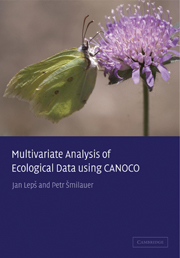Book contents
- Frontmatter
- Contents
- Preface
- 1 Introduction and data manipulation
- 2 Experimental design
- 3 Basics of gradient analysis
- 4 Using the Canoco for Windows 4.5 package
- 5 Constrained ordination and permutation tests
- 6 Similarity measures
- 7 Classification methods
- 8 Regression methods
- 9 Advanced use of ordination
- 10 Visualizing multivariate data
- 11 Case study 1: Variation in forest bird assemblages
- 12 Case study 2: Search for community composition patterns and their environmental correlates: vegetation of spring meadows
- 13 Case study 3: Separating the effects of explanatory variables
- 14 Case study 4: Evaluation of experiments in randomized complete blocks
- 15 Case study 5: Analysis of repeated observations of species composition from a factorial experiment
- 16 Case study 6: Hierarchical analysis of crayfish community variation
- 17 Case study 7: Differentiating two species and their hybrids with discriminant analysis
- Appendix A Sample datasets and projects
- Appendix B Vocabulary
- Appendix C Overview of available software
- References
- Index
7 - Classification methods
Published online by Cambridge University Press: 09 February 2010
- Frontmatter
- Contents
- Preface
- 1 Introduction and data manipulation
- 2 Experimental design
- 3 Basics of gradient analysis
- 4 Using the Canoco for Windows 4.5 package
- 5 Constrained ordination and permutation tests
- 6 Similarity measures
- 7 Classification methods
- 8 Regression methods
- 9 Advanced use of ordination
- 10 Visualizing multivariate data
- 11 Case study 1: Variation in forest bird assemblages
- 12 Case study 2: Search for community composition patterns and their environmental correlates: vegetation of spring meadows
- 13 Case study 3: Separating the effects of explanatory variables
- 14 Case study 4: Evaluation of experiments in randomized complete blocks
- 15 Case study 5: Analysis of repeated observations of species composition from a factorial experiment
- 16 Case study 6: Hierarchical analysis of crayfish community variation
- 17 Case study 7: Differentiating two species and their hybrids with discriminant analysis
- Appendix A Sample datasets and projects
- Appendix B Vocabulary
- Appendix C Overview of available software
- References
- Index
Summary
The aim of classification is to obtain groups of objects (samples, species) that are internally homogeneous and distinct from the other groups. When the species are classified, the homogeneity can be interpreted as their similar ecological behaviour, as reflected by the similarity of their distributions. The classification methods are usually categorized as in Figure 7–1.
Historically, numerical classifications were considered an objective alternative to subjective classifications (such as the Zürich-Montpellier phytosociological system, Mueller-Dombois & Ellenberg 1974). They are indeed ‘objective’ by their reproducibility, i.e. getting identical results with identical inputs (in classical phytosociology, the classification methods obviously provide varying results). But also in numerical classifications, the methodological choices are highly subjective and affect the final result.
Sample data set
The various possibilities of data classification will be demonstrated using vegetation data of 14 relevés from an altitudinal transect in Nízké Tatry Mts, Slovakia. Relevé 1 was recorded at an altitude of 1200 metres above sea level (m a.s.l.), relevé 14 at 1830ma.s.l. Relevés were recorded using the Braun–Blanquet scale (r, +, 1–5, see Mueller-Dombois & Ellenberg 1974). For calculations, the scale was converted into numbers 1 to 7 (ordinal transformation, Van der Maarel 1979). Data were entered as a classical vegetation data table (file tatry.xls) and further imported (using the WCanoImp program) into the condensed Cornell (CANOCO) format (file tatry.spe), to enable use of the CANOCO and TWINSPAN programs. The data were also imported into a Statistica file (file tatry.sta).
Information
- Type
- Chapter
- Information
- Multivariate Analysis of Ecological Data using CANOCO , pp. 96 - 116Publisher: Cambridge University PressPrint publication year: 2003
